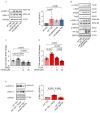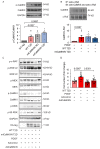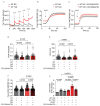Regulation of Smooth Muscle Cell Proliferation by Mitochondrial Ca2+ in Type 2 Diabetes
- PMID: 37629079
- PMCID: PMC10454141
- DOI: 10.3390/ijms241612897
Regulation of Smooth Muscle Cell Proliferation by Mitochondrial Ca2+ in Type 2 Diabetes
Abstract
Type 2 diabetes (T2D) is associated with increased risk of atherosclerotic vascular disease due to excessive vascular smooth muscle cell (VSMC) proliferation. Here, we investigated the role of mitochondrial dysfunction and Ca2+ levels in VSMC proliferation in T2D. VSMCs were isolated from normoglycemic and T2D-like mice induced by diet. The effects of mitochondrial Ca2+ uptake were studied using mice with selectively inhibited mitochondrial Ca2+/calmodulin-dependent kinase II (mtCaMKII) in VSMCs. Mitochondrial transition pore (mPTP) was blocked using ER-000444793. VSMCs from T2D compared to normoglycemic mice exhibited increased proliferation and baseline cytosolic Ca2+ levels ([Ca2+]cyto). T2D cells displayed lower endoplasmic reticulum Ca2+ levels, reduced mitochondrial Ca2+ entry, and increased Ca2+ leakage through the mPTP. Mitochondrial and cytosolic Ca2+ transients were diminished in T2D cells upon platelet-derived growth factor (PDGF) administration. Inhibiting mitochondrial Ca2+ uptake or the mPTP reduced VSMC proliferation in T2D, but had contrasting effects on [Ca2+]cyto. In T2D VSMCs, enhanced activation of Erk1/2 and its upstream regulators was observed, driven by elevated [Ca2+]cyto. Inhibiting mtCaMKII worsened the Ca2+ imbalance by blocking mitochondrial Ca2+ entry, leading to further increases in [Ca2+]cyto and Erk1/2 hyperactivation. Under these conditions, PDGF had no effect on VSMC proliferation. Inhibiting Ca2+-dependent signaling in the cytosol reduced excessive Erk1/2 activation and VSMC proliferation. Our findings suggest that altered Ca2+ handling drives enhanced VSMC proliferation in T2D, with mitochondrial dysfunction contributing to this process.
Keywords: calcium; proliferation; type 2 diabetes; vascular smooth muscle cells.
Conflict of interest statement
The authors have declared that no conflict of interest exists.
Figures







Update of
-
The mitochondrial regulation of smooth muscle cell proliferation in type 2 diabetes.bioRxiv [Preprint]. 2023 Feb 16:2023.02.15.528765. doi: 10.1101/2023.02.15.528765. bioRxiv. 2023. Update in: Int J Mol Sci. 2023 Aug 17;24(16):12897. doi: 10.3390/ijms241612897. PMID: 36824758 Free PMC article. Updated. Preprint.
Similar articles
-
The mitochondrial regulation of smooth muscle cell proliferation in type 2 diabetes.bioRxiv [Preprint]. 2023 Feb 16:2023.02.15.528765. doi: 10.1101/2023.02.15.528765. bioRxiv. 2023. Update in: Int J Mol Sci. 2023 Aug 17;24(16):12897. doi: 10.3390/ijms241612897. PMID: 36824758 Free PMC article. Updated. Preprint.
-
Mitochondrial Calcium Uniporter Regulates Metabolic Remodeling and Smooth Muscle Cell Proliferation in Type 2 Diabetes.J Am Heart Assoc. 2025 Aug 5;14(15):e039220. doi: 10.1161/JAHA.124.039220. Epub 2025 Jul 17. J Am Heart Assoc. 2025. PMID: 40673552
-
Vascular endothelial growth factor stimulates a novel calcium-signaling pathway in vascular smooth muscle cells.Surgery. 2005 Oct;138(4):780-7. doi: 10.1016/j.surg.2005.07.010. Surgery. 2005. PMID: 16269309
-
Cigarette tar accelerates atherosclerosis progression via RIPK3-dependent necroptosis mediated by endoplasmic reticulum stress in vascular smooth muscle cells.Cell Commun Signal. 2024 Jan 16;22(1):41. doi: 10.1186/s12964-024-01480-6. Cell Commun Signal. 2024. PMID: 38229167 Free PMC article.
-
Antiatherosclerotic Effect and Molecular Mechanism of Salidroside.Rev Cardiovasc Med. 2023 Mar 23;24(4):97. doi: 10.31083/j.rcm2404097. eCollection 2023 Apr. Rev Cardiovasc Med. 2023. PMID: 39076283 Free PMC article. Review.
Cited by
-
Novel Factors Regulating Proliferation, Migration, and Differentiation of Fibroblasts, Keratinocytes, and Vascular Smooth Muscle Cells during Wound Healing.Biomedicines. 2024 Aug 23;12(9):1939. doi: 10.3390/biomedicines12091939. Biomedicines. 2024. PMID: 39335453 Free PMC article. Review.
-
High Glucose Levels Promote Switch to Synthetic Vascular Smooth Muscle Cells via Lactate/GPR81.Cells. 2024 Jan 26;13(3):236. doi: 10.3390/cells13030236. Cells. 2024. PMID: 38334628 Free PMC article.
-
The role of ERK1/2 signaling in diabetes: pathogenic and therapeutic implications.Front Pharmacol. 2025 May 9;16:1600251. doi: 10.3389/fphar.2025.1600251. eCollection 2025. Front Pharmacol. 2025. PMID: 40417223 Free PMC article. Review.
-
Mitochondrial influences on smooth muscle phenotype.Am J Physiol Cell Physiol. 2024 Feb 1;326(2):C442-C448. doi: 10.1152/ajpcell.00354.2023. Epub 2023 Nov 27. Am J Physiol Cell Physiol. 2024. PMID: 38009196 Free PMC article. Review.
-
The Mitochondrial Permeability Transition Pore in Platelets: Mechanisms, Physiological Roles, and Therapeutic Perspectives.Antioxidants (Basel). 2025 Jul 29;14(8):923. doi: 10.3390/antiox14080923. Antioxidants (Basel). 2025. PMID: 40867821 Free PMC article. Review.
References
MeSH terms
Substances
Grants and funding
LinkOut - more resources
Full Text Sources
Medical
Molecular Biology Databases
Research Materials
Miscellaneous

